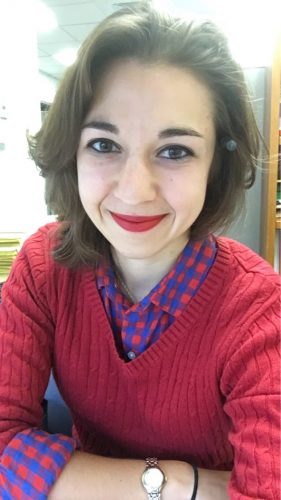Amy is a graduate student in UW-Milwaukee’s coordinated degree program for a Master of Library and Information Science and a Master of Arts in History. She has been working with the Encyclopedia of Milwaukee since January 2018 as a Research Assistant. She specializes in doing our image research.
Amy came to UW-Milwaukee after receiving her undergraduate degree from Ripon College with a major in history and double minor in English and non-profit management. Her undergraduate work in the archives at Ripon trained her in digitizing photographs and curating both physical and digital exhibits—skills she now uses in her work for the Encyclopedia of Milwaukee. Her internship with the Oshkosh Public Museum further prepared her for thinking critically about how to represent history and information visually and for broad audiences.
But what exactly does an image researcher do? Amy’s tasks may seem simple at first: to locate, select, and prepare images that accompany our encyclopedia entries. But selecting visual content to accompany an encyclopedia entry involves a lot of time mining archives for relevant and quality images as well as thinking critically about how to represent a topic in a way that is consistent with both the entry itself and with the high objective standards required of an encyclopedia. As Amy explains, the challenge in her task lies in questions such as “how do you represent a broad topic in images? Or, how do you choose which one or two images best encompass meaning for a 1,000 word entry?” But finding the right image is rewarding as well. Amy explains, “Having images with our entries not only improves access, but readers then get to see their community represented and feel more connection to it.”
Another important task is negotiating contracts with the repositories that hold the images and arranging for the Encyclopedia of Milwaukee to have the right to use and reproduce these images. Amy is in frequent contact with local institutions such as the Wisconsin Historical Society and the Milwaukee Public Library as she explores their collections, working with their librarians and archivists to ensure we follow copyright laws. As Amy sees it, this is an incredible opportunity to make a lot of contacts and develop great professional relationships in the local archives community. Amy ensures that all of the images included on the website are cited correctly; it’s important to give credit to the preservation and access work done by local archives and libraries, just as it’s important for readers to be able to find the original source of the image. “We want people to be able to trace our work and then use it to expand their own,” she explains. “We want to be the jumping off point for our readers and researchers.”
Of course, some images also come from open sources. “What most people don’t realize is how the community provides input for our work through sites such as Flickr and the Wikimedia Commons,” Amy notes. In this way, the community is already participating in the project. But, one thing that she wants to see moving forward is getting more people to explore the site, spread the word, and participate by registering and adding comments. As Amy describes it, there is something special and inspiring about exploring the Encyclopedia of Milwaukee website, “You can get lost in the history, once you start exploring you just keep going and you can learn so much about your community!”
–Katie Stollenwerk

0 Comments
Please keep your community civil. All comments must follow the Encyclopedia of Milwaukee Community rules and terms of use, and will be moderated prior to posting. Encyclopedia of Milwaukee reserves the right to use the comments we receive, in whole or in part, and to use the commenter's name and location, in any medium. See also the Copyright, Privacy, and Terms & Conditions.
Have a suggestion for a new topic? Please use the Site Contact Form.